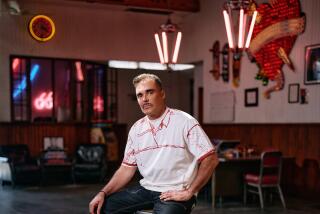CAMERATHON TO BECOME A BOOK : WESTERN PHOTOGRAPHERS GET A SHOT AT U.S.S.R.
- Share via
MOSCOW — Fifty Western photographers who were allowed to travel widely in the Soviet Union and take pictures for a book on daily life this month found familiar restrictions but also unprecedented access to some areas.
One photographer got into a Soviet prison. Others were permitted to photograph an elite army unit, go to areas officially off limits and even photograph babies being born.
Others were effectively prevented from taking pictures of everyday realities--long lines of people waiting to buy liquor, for example.
The Western group, along with 50 Soviet and Eastern Bloc photographers, took about 100,000 pictures on a single day, May 15. The number will be reduced to 350 or so for a book to be called “A Day in the Life of the Soviet Union.” Other books in the series include ones about the United States, Japan and Australia.
The photographers assembled here Sunday to turn in their film, which will be developed in Spain, and to swap stories about their experiences.
The incident was regarded as a test of the new policy of glasnost , or openness, that has been adopted by Soviet leader Mikhail S. Gorbachev. Ironically, an American request to photograph the human side of Gorbachev, at home with his family, was turned down.
David Kennerly, who was the personal photographer for President Gerald R. Ford, had expected to get the Gorbachev assignment but was sent instead to a Soviet Navy prep school.
A Soviet photographer was assigned to Gorbachev and was permitted to make just one picture, a formal shot of Gorbachev and visiting French Prime Minister Jacques Chirac.
“If they really wanted to show openness, they would have allowed a Western photographer to be with him (Gorbachev),” Kennerly told a reporter. “Overall, they did extend themselves more than they have before, but there’s a long way to go and it’s not going to happen tomorrow.”
Eddie Adams, a Pulitzer Prize-winning photographer, was allowed inside Vladimir Prison, but he complained that he was given only 40 minutes and was not shown any cells. He saw only a dormitory, an empty mess hall, a classroom, the library and a yard where prisoners were playing chess.
“I had three colonels with me, and they had to give permission each time I wanted to take a picture,” Adams said. “By the time we discussed it, the picture was gone.”
Peter Turnley, a Newsweek photographer, fared better. He went to Bokhara, in the Republic of Uzbekistan in Central Asia, and was able to take pictures of two Muslim funerals and a midwife delivering babies.
“I felt the access was, frankly, tremendous,” he said. “I work here often, and I never had so much access.”
Anne Day, who went to an area in the North Caucasus where many ethnic groups live, said she wanted to stay with a family but was put up at the Intourist hotel.
“Everywhere I went people were pulling out their ethnic costumes and dancing,” she said.
Letizia Battaglia, a photographer for a Sicilian newspaper who specializes in covering the Mafia, was sent to Archangel, in the far North, and she said that all her requests were approved.
“I got to photograph live births, a lot of babies,” she said, even though Day was told that it was impossible for her to take pictures of newborns in her area.
Mary Ellen Mark, a New York free-lancer, was delighted by her assignment in Kiev, where she photographed children at a school for the blind and at a break-dancing club.
Wally McNamee, a White House photographer with Newsweek, went to Stavropol, where Gorbachev used to be a party leader. McNamee’s request to photograph Gorbachev’s mother, who lives in the Stavropol area, was turned down. His local escort, a party official, was “very nervous--very afraid that I would take some kind of picture that would embarrass Stavropol and ruin his career.”
Dirck Halstead of Time magazine said that in Ulyanovsk he saw a ballet performance of a new work, “The Three Musketeers,” and that it was so erotic it reminded him of a Las Vegas floor show.
D. Gorton, from Cincinnati, got a prize assignment to visit an elite Red Army division assigned to guarding Moscow.
“They wanted to give me a Potemkin village,” he said. “When I protested, they gave me free rein for three hours.”
Graeme Outerbridge, who went to Birobidzhan in the Jewish Autonomous Republic, said he was prevented from taking a picture of 1,000 people standing in line to buy liquor. He said his escort told him: “I think it will be very dangerous for you. We’d better go now.”
David Cohen, editor of the book, said the outcome was “better than we could possibly have expected.”
The refusal to allow a photographer to spend a day with Gorbachev was the worst setback, he said.
He estimated that only 10% of the photographers encountered problems. But a colleague, Rick Smolan, estimated that 15 of the 50 Westerners, nearly a third, had difficulties with their guides.
More to Read
Sign up for Essential California
The most important California stories and recommendations in your inbox every morning.
You may occasionally receive promotional content from the Los Angeles Times.













